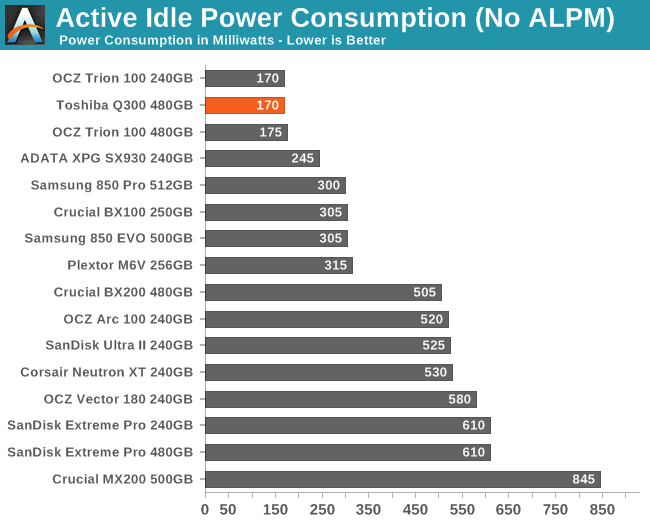The Toshiba Q300 SSD Review: Toshiba Becomes a Retail Brand
by Billy Tallis on February 26, 2016 8:00 AM ESTIdle Power Consumption
Since the ATSB tests based on real-world usage cut idle times short to 25ms, their power consumption scores paint an inaccurate picture of the relative suitability of drives for mobile use. During real-world client use, a solid state drive will spend far more time idle than actively processing commands. Our testbed doesn't support the deepest DevSlp power saving mode that SATA drives can implement, but we can measure the power usage in the intermediate slumber state where both the host and device ends of the SATA link enter a low-power state and the drive is free to engage its internal power savings measures.
We also report the drive's idle power consumption while the SATA link is active and not in any power saving state. Drives are required to be able to wake from the slumber state in under 10 milliseconds, but that still leaves plenty of room for them to add latency to a burst of I/O. Because of this, many desktops default to either not using SATA Aggressive Link Power Management (ALPM) at all or to only enable it partially without making use of the device-initiated power management (DIPM) capability. Additionally, SATA Hot-Swap is incompatible with the use of DIPM, so our SSD testbed usually has DIPM turned off during performance testing.
Our SATA power measurements are conducted using a meter with a resolution of 1mA for the current on the 5V rail, giving our power consumption scores a resolution of 5mW. (The meter can offer microampere resolution for currents up to 400mA, but many drives would blow that fuse before the OS could put them to sleep.)

For mobile use, the Q300 falls in the second tier of drives that have acceptable but not great power consumption in the slumber state. Differences of a few tens of milliwatts won't have much impact on battery life for the kinds of devices that use 2.5" drives rather than M.2 or mSATA SSDs.

In a desktop situation with SATA ALPM disabled, the Q300 and Trion 100 offer the best idle power consumption. The other low-end TLC drives are drawing three times as much power.










30 Comments
View All Comments
bill.rookard - Friday, February 26, 2016 - link
MX100's are awesome drives, I have a pair in my webserver with a M4 for the boot drive. Sadly, the whole issue appears to be (with the exception of Samsungs drives) the TLC. When having to account for the 8 different voltage states required for 3 bit per cell it seems that the controllers are not up to the task of getting things done quickly.I'm thinking widespread adoption of V-nand (regardless of manufacturer) along with MLC in a larger lithography will wind up being the perfect storm of capacity, price, speed and endurance.
Arnulf - Friday, February 26, 2016 - link
TLC cells have 8 distinct voltage levels per cell to make up for 3 bits of information, not 3.hojnikb - Friday, February 26, 2016 - link
thats what he said.kmmatney - Friday, February 26, 2016 - link
No, he said 3, not 3vladx - Friday, February 26, 2016 - link
"No, he said 3, not 3"Huh?
boozed - Friday, February 26, 2016 - link
It's really quite simple. He said 3, not 3.extide - Friday, February 26, 2016 - link
I think what we will see is 3D TLC in pretty much all mainstream stuff, and 3D MLC in the high performance stuff.Samus - Friday, February 26, 2016 - link
It's too bad the MX100 and BX100 are harder and harder to find, when the MX200 and ESPECIALLY the BX200 are inferior.leexgx - Friday, February 26, 2016 - link
the BX100 its perfect for laptops as its super power efficient, the MX100/BX100 is the most use the most power SSD (the Adata Sp550 also uses the BX200 controller)leexgx - Friday, February 26, 2016 - link
ops!! MX200/B200 or any SSD that uses TLC with SLC cache seem to be extremely high power usage, for minimal overall speed boost (and higher chance of data loss due to SLC/TLC data movement)